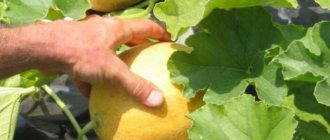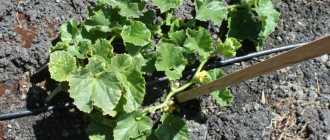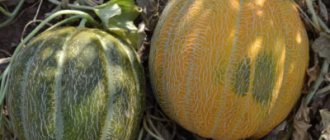Melon is a dessert vegetable with a rich sweet taste and delicate aroma. Despite its sweetness, it is considered a dietary product, since it consists of 90% water and promotes complete digestion. In addition, it is rich in vitamins and minerals.
Hot Central Asia is considered the homeland of melon, but thanks to the achievements of modern breeders, this honey plant is also grown in central Russia. However, to obtain a rich harvest, you need to know the nuances of caring for the crop. One of them is the formation of a bush.
In this article we will tell you how to pinch a melon and when to start shaping in open ground.
The importance of correct and timely formation of melon
Melon is grown both in open ground and in greenhouses. The crop is sown in prepared soil with seeds or planted as seedlings.
When cultivating in open ground, removing excess shoots from melon is a necessary condition for obtaining a good harvest.
Pinching limits the growth of green mass of the bush and allows you to grow larger fruits. In addition, the melons will ripen earlier and taste sweeter.
When growing large-fruited varieties, part of the fruit ovaries is also removed. From 3 to 6 fruits are left per bush.
The secret of sweet melon
Melon has long been grown only in the south (from 6 to 8 frost resistance zones), where the dry and hot climate allows the fruits to ripen without any tricks.
Frost resistance zones of plants are determined by the minimum temperature
On the creeping stems of this melon crop, 2–8 fruits weighing from 1 to 10 kilograms can ripen. However, in areas with a colder climate, gardeners have to try and resort to techniques aimed at reducing the ripening time of melon and obtaining larger fruits - forming a plant bush and normalizing the number of ovaries on it.
If too many ovaries form on the melon, it is recommended to remove some of them
Planting dates and site preparation
The site for planting melons begins to be prepared in the fall. Considering the southern origin of the plant, choose a sunny, dry place, protected from cold winds. If the soil in the garden is clayey, add additional river sand (about 1 bucket per 1 sq. m).
The earth is dug up deeply and fertilized. Humus is added at the rate of 3–4 kg per 1 sq. m. m. In the spring, the bed is dug up again, potassium and phosphate fertilizers are added.
In the south of Russia, melon is sown with seeds in open ground in late April - early May. In the central zone of our country, the crop is grown only through seedlings.
Need to know! Melon seeds used for sowing must be at least three years old. Mostly male plants grow from fresh seeds, therefore there will not be a good harvest.
Peat containers are perfect for seedlings. It is convenient to plant such seedlings together with pots, and peat will serve as an additional fertilizer.
Soil preparation
Melons need light, air- and water-permeable soil, preferably sandy loam. Dry, slightly saline soils can be used for melons. The culture does not tolerate heavy, floating soils. After harvesting the predecessor, provocative irrigation is used to obtain weed seedlings, which are destroyed by deep digging, it is possible with rotation of the layer on southern chernozems and without rotation - on turf and other soils. For digging, scatter 0.5 buckets of compost or humus and 200-250 g of ash per square meter. m area.
If the site has not been fertilized with organic matter for a long time, but only with mineral fertilizers, it may acquire increased acidity. In such areas it is necessary to carry out liming. Spread 300 g of lime on sandy loam and sandy types of soil and 400 g on loamy soils and seal it in a 10 cm layer. When the top layer of soil (10-15 cm) ripens and warms up to +12..+14°C, nitrophoska is added at 70-80 g/sq.m. m. Before sowing melons or planting seedlings, the field is filled with nitrogen fertilizers of 10-20 g/sq. m for cultivation.
Melon seedlings. Lexa
Basic rules for forming a melon in open ground
In the wild, melon bushes grow greatly. This is explained by the southern origin of the culture. However, in our climate there are no conditions for the filling and ripening of all the fruits on the bush. Therefore, only the largest and healthiest ones are left, no more than 3-4 per bush.
Features of culture formation
Pinching melon bushes is one of the main agricultural practices that allows you to grow large fruits. This procedure should not be underestimated. Without it, there simply will not be a good harvest.
The formation of a plant consists of removing excess ovaries and timely pinching out unnecessary shoots.
In addition, pinching helps regulate the growth of vines and guide them so that they do not overlap row spacing.
Formation methods
When grown in open ground, the crop is formed in two ways: vertical and horizontal.
The vertical method involves constructing a strong frame to which ropes or wires are tied. The height of the structure is about 2 m. The lower end of each rope hangs down to the melon. Loose lashes and newly emerging shoots are wound on a rope.
The obvious advantage of this method is that the plant receives more light, which has a positive effect on yield. In addition, caring for the bushes is greatly simplified.
With the horizontal method of formation, the crop grows freely on the ground. Keep in mind that the melon requires a large area for the growth and branching of the vines.
Formation schemes
The formation of the plant is carried out by pinching the shoots. Hybrid and non-hybrid varieties have different formation patterns.
In hybrid varieties, the main vine is not pinched - the female flowers are located on it. In non-hybrid ones, the main shoot is pinched, leaving 2-3 most developed side shoots.
Stages of the procedure
The formation of a bush begins early, even at the stage of growing seedlings. When 3-4 true leaves have formed on the sprout, the main shoot grows in the axil of the main leaf. He is immediately pinched.
After this operation, lateral shoots are formed in the axils of the lower leaves. It is on these lateral branches that most of the fruits will subsequently form.
When growing melon in open ground, 2-3 of the strongest shoots are left from the first side shoots. This is the second stage of bush formation.
The third stage is carried out at the beginning of the formation of ovaries. At this last stage, all underdeveloped lashes and branches without ovaries are mercilessly removed.
Pinching seedlings
Pruning is done when the melons are young shoots. As a rule, in this phase the plant has no more than 5 leaves. The grown shoots are seedlings. This is the most suitable period for pinching melons.
Pinching when growing melon vertically in a greenhouse
The formation of one stem is convenient for growing melons and melons in a greenhouse. In this case, all secondary shoots must be removed. The procedure is repeated when the central stem reaches 2 meters in length (height). Pruning of shoots of the second level is carried out above 3-4 leaves, taking into account the presence of the ovary. If the branches are not covered with ovaries, they are pruned.
If the vertical method was chosen for growing melon, each fruit is hung.
They need to be secured, as there is a risk of breakage due to the heavy weight. Pinching the melon correctly is important, but also, during the growing stage, attention should be paid to pollination. If there is no ovary on the stems, this may be due to lack of pollination. When they are grown in closed soil, few, if any, bees will enter the greenhouse. At the same time, the humidity level in the room is increased.
Pinching when growing melon horizontally in a spread
To form a bush using this method, preference is given to open ground. Due to the need for a large area of soil, it is not suitable for a greenhouse. High humidity levels can promote disease. This is inevitable, since the lashes completely cover the ground.
After the first pinching of the seedlings, 3 stems are formed. For spreading cultivation, choose 2 shoots that are most developed. The procedure is repeated after the third pair of sheets. The last pinching is carried out at the moment of formation of the ovaries:
- Thin vines are cut off because they are unable to bear fruit.
- They do pinching of melons.
- For a plant, a cut is a wound. The pinched area is treated with charcoal and sulfur.
See also
Description of cantaloupe variety cantaloupe, planting and care rules
Read
When choosing a horizontal formation of a melon, the area of the land plot is taken into account. There should be free space between the melon beds.
How and where to pinch a melon
The shoots are removed carefully so as not to pinch the main stem of the plant. The side branches that grew after the main shoot was removed are pinched above the 4-6 leaf.
After the fruits have formed on the bush and begun to swell, the fruiting vines are pinched. Trim the vine 3-4 leaves above the fruit.
Leave 2-3 melons on one plant if it is a large-fruited variety, and 4-6 if the fruits are medium-sized.
To protect against diseases and pests, the cutting sites are treated with a mixture of sulfur, coal and lime. The components are mixed in equal parts and the damaged areas are lubricated.
Pinching early and late varieties
The pinching scheme for early and late ripening varieties of melons differs in some respects. Before pruning, you should clarify all the details so as not to harm the plant. As for early varieties, as a rule, they need to be pinched off the central shoot. After this, it is necessary to monitor the appearance of ovaries. Early melons ripen quickly, so they need much less energy to feed.
Pruning of late-ripening varieties is carried out more often. The ripening period of the crop depends on the number of melons left on the bush. Experienced gardeners try to leave as little fruit as possible. Ripe melon turns out sweet, with an incredible aroma.
Most common mistakes
Stepping is not the simplest agrotechnical technique. If done incorrectly, the quantity and quality of the harvest is reduced.
We list the main mistakes made by gardeners:
- Pinching a melon bush in the same way as a watermelon bush. Although melon and watermelon are related plants, they set fruit differently. In watermelon, fruits are formed on the main shoot, and in melon - on the side shoots.
- Thickening of plantings. Melon bushes need a lot of space to grow and develop. Even pinching, carried out according to all the rules, will not help to get a good harvest if the plants are planted too densely.
- Insufficient removal of shoots. There is no point in sparing the extra lashes. Otherwise, all the nutrients will go into the leaves and stems, few ovaries will form, and the fruits will be small and unsweetened.
Further formation of bushes
After pinching the melons, the formation of lashes is constantly carried out. During the development period, plants monitor the growth of shoots, the appearance of flowers and the formation of fruits. It is periodically necessary to adjust the number of ovaries until full maturity. The acceptable number of melons on one branch is 4.
When growing melons, it is important to leave as few fruits as possible after pinching. This technique will have a positive effect on growth. They will grow big and sweet. Pruning is mandatory, since the appearance of additional shoots and ovaries takes away the nutrients and strength of the crop.
The importance of pinching for yield
The formation of melon when growing seedlings in open ground is important for further productivity. The main role here is played by pinching the growth points of the bush.
It is not recommended to skip this method of agricultural technology. The main shoots are left, and the rest is cut off. The growth point on the main shoot is pinched, which is why side shoots are formed.
It is on the side shoots that the ovaries, and subsequently the fruits, are formed. After this procedure, all nutrients do not enter the leaves and stems, but directly into the fruits and they ripen a week earlier. The melons become much larger and taste sweeter. The main thing is that after pinching, several side shoots form. If you do not cut off the top of the main stem, then fruits may not form on such plants at all.
How pinching can affect the harvest
When growth points on a bush are removed, this has a positive effect on the taste of the fruit and overall yield, accelerated growth and onset of ripening. Pinching allows you to ensure that lateral ovaries form on the bush. Beneficial substances enter the fruits, and not the branches. Melon bears fruit a week or two earlier.
If you neglect to pinch the branches, then not a single melon may grow on adult bushes at all. And all because with this approach, the lateral ovaries either will not form or there will be too few of them and they rarely bear fruit.
Pinching at the seedling stage
When the melon sprouts are still very small, you can already carry out the first stage of pinching. The main thing is that the seedlings should have 5-6 full-fledged leaf blades. After the procedure, the main stem will grow in the axil of the main leaf, and the main stems will form in the axils of the rest.
Pinching when growing plants vertically
In greenhouse conditions, plants are formed into one stem, the rest are removed. This is the second pinching, carried out when the central lash of the bush grows to 2 meters. All side branches are removed at 3-4 leaves, if there are no ovaries on them.
If you grow melons in a vertical position, place all the fruits that are already ripening in large, spacious nets and tie them to the frame so that they do not break under their own weight.
Pollination is also important when growing melons in greenhouse conditions, because bees almost do not penetrate into the room, and the humidity in it is high. It must be done manually
If you neglect the process, the ovaries may not form.
Pinching when growing horizontally
Used for melons growing in the garden. It is not suitable for greenhouse plants, because... irrational due to the small area of the room and the risk of infection of the bushes, which arises due to too high humidity (it is simply inevitable, because the soil will constantly be overgrown with melon branches) and poor lighting.
When growing in a spread pattern, as soon as 3 shoots are formed (after the first pinching), the smallest of them is removed. The procedure must be carried out after the appearance of 5-7 sheets.
The last, third pinching is carried out at the stage of ovary formation:
- small, low-power, non-fruiting branches are removed;
- remove all ovaries above the 5-6th leaf from the first melon;
- All treated areas are lubricated with sulfur, coal or limestone.
How to pinch early and late melon varieties
Early varieties are formed only by harvesting the main branch, and then the number of ovaries is controlled, since the fruits on such bushes will appear very quickly and they need much less nutrients and energy than late-ripening ones. The pinching time depends not only on the germination method, but also on the timing of fruiting.
Late-ripening varieties are processed more often, and fewer fruit-bearing branches are left on them. This helps to reduce their ripening time and saves energy costs. Scheme for pinching late-ripening melons:
https://sveklon.ru/kak-prishhipyvat-dynihttps://dachamechty.ru/dynya/formirovanie.htmlhttps://ogorod-bez-hlopot.ru/pravilno-prishhipyvat-dyni.html
About the need to form watermelons
Watermelons have unlimited growth of vines. If you do not pinch them, fruits will form along the entire trunk and on the side shoots. The lashes grow further, the bush spends energy both on their development and on the formation of more and more new fruits. As a result, we will get long stems and many small watermelons on them. In Africa and Australia, they will, of course, ripen, but not in our extreme climate.
Wild watermelons grow in Australia and southern Africa
By shaping we stop the excessive growth of shoots, and by rationing we leave only a few fruits on the bush. The plant will direct all its energy to growing and ripening them. It turns out that the bush itself, without any pinching, tends to become wild. And only under the supervision of a skilled gardener does it turn into a cultivated and productive plant.
Correct pinching pattern (order of implementation)
The sequence must be observed in any case, otherwise the yield will drop sharply. Subsequence:
- The fruits are formed on the side parts of the bush. You need to wait until the first 6-7 sheets appear. After them, the ovaries and flowers will begin to grow.
- The growing point is always removed so that the juices flow only to the fruit-bearing branches.
- After germination of the 8th leaf, you need to pinch it around the 4th. Then several shoots will grow; you only need to leave a couple of the most powerful ones. They are also pinched over the 6th and 7th leaves.
- As soon as the branches begin to form, you will need to leave only 6-7 - they will form ovaries and bear fruit. It is important to leave only those that are closer to the trunk. This is necessary for their maximum saturation with energy. All other branches are pinched if very small melons grow on them.
- After two to three weeks, all fruitful shoots are cut off at the top, and the rest are pinched off above the 5th or 6th leaf. Flowers are also removed. To prevent the melons from rotting, you need to place small pieces of plywood under them.











